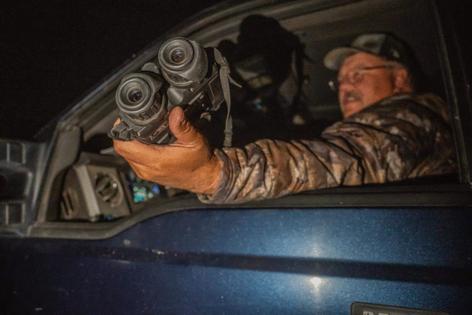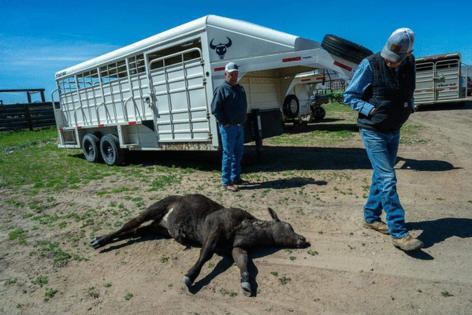California kills 4 wolves, removes pack after Sierra cattle attacks
Published in News & Features
California wildlife officials euthanized four gray wolves in Sierra Valley and plan to relocate three more to a wildlife sanctuary, after months of nonlethal efforts failed to prevent livestock attacks that cost ranchers tens of thousands of dollars and terrified residents.
The dramatic steps will have the effect of moving the entire Beyem Seyo pack away from Sierra Valley, where the wolves had become habituated to preying on cattle — to a degree that state conservation officials describe as highly unusual for the protected apex predators.
The euthanizations, which occurred earlier this month, marked the first time in more than a century that California officials have killed wolves, which remain protected under both state and federal endangered species laws. Environmentalists called the decision a tragedy.
“It’s hard, and it weighs on you,” Charleton H. Bonham, director of the California Department of Fish and Wildlife, said in an interview with The Sacramento Bee. “This decision was not made lightly.”
The situation highlights a problem that is playing out throughout the West as environmental protections allow wolves to begin to return to the landscape after they were hunted to near-extinction. Some states have removed wolves from protected species lists and begun to allow them to be hunted anew. Federal protections for wolves have also been relaxed in some western states.
In California, Sierra Valley’s experience with wolves comes against a backdrop of growing concern about wildlife predators in California, as coyotes, mountain lions and bears — along with wolves — are increasingly coming into contact with human communities.
The state is beginning a process of re-evaluating protections for the gray wolf, but the move is likely to be contentious, with environmentalists arguing for stringent protections, and some residents of rural areas terrified of what could go wrong if a pack becomes used to eating livestock and living near humans.
Three of the wolves euthanized last week in Sierra Valley were adults. They were tranquilized from the air before receiving lethal injections from biologists on the ground, Bonham said. A few days earlier, a six-month-old pup was mistaken for an adult and killed unintentionally, officials said, by a firearm shot from a helicopter.
The Beyem Seyo pack — three adults and six juveniles — killed 87 cattle between late March and mid-October, according to Bonham, hunting more livestock in seven months than the roughly 200 wolves in neighboring Oregon attacked in an entire year.
The unrelenting attacks, followed by bloody discoveries nearly every morning, created panic and distrust among local ranchers and strained law enforcement resources in the bucolic valley 100 miles northeast of Sacramento.
“This dynamic with this particular pack is far outside the known experience in any other western state,” Bonham said.
Celebration gives way to concern
Wolves’ return to the state a century after they were hunted to local extinction has been a scientific and conservation success story, starting in 2011 when a wolf dubbed OR7 crossed into the state from Oregon. Today, there are an estimated 50 to 70 of the storied canines in the state, and they have created 10 packs.
Because wolves are protected under the Endangered Species Act, individuals may not kill them unless directly threatened. Ranchers also face restrictions on hazing or scaring them away.
But when the Beyem Seyo pack established itself in the high rangeland straddling Plumas and Sierra counties, scientific celebration gave way to practical concerns, as adult wolves began preying on the thousands of cattle ranchers send there each summer to graze.
The decision to euthanize the adults and relocate the juveniles to a sanctuary — where they won’t pass on livestock-hunting behaviors — came after state wildlife officials exhausted other methods of containing them, Bonham said.
Members of a state strike team sent to use nonlethal methods to scare the wolves away from ranches spent 18,000 hours in Sierra Valley over 114 days this summer, Bonham said, and were able to chase wolves away from attacks that might have killed an additional 95 cattle. In August, a team of federal wolf specialists lit up the night sky every night with drone attacks aimed at driving the wolves away.
“We threw everything at it for months to change their behavior,” said Bonham.
At one point, biologists fed the wolves and their pups roadkill and other animal carcasses, hoping in vain to curb their taste for hunting cattle. But, by late September, officials decided that lethal intervention was necessary, Bonham said. He and his team consulted with federal officials, who also had to agree that the pack was unusually aggressive and that killing the adults was necessary.
Starting around Oct. 11, wildlife officers combed the area in helicopters, tracking down the three adults and the juvenile that was killed after about two weeks, said Jen Benedet, a spokesperson for the department. They have not yet found the remaining juveniles, who are believed to be about six months old. The remains of two more pups from the pack were also found by biologists, and appear to have died of natural causes, she said.
The state’s wildlife experts are hopeful that removing the Beyem Seyo pack will not impede the resurgence of wolves in California, because the nine other packs in the state have experienced robust growth, with at least four breeding pairs remaining, said CDFW Deputy Director Chad Dibble, who oversees the department’s science and species conservation efforts.
“By removing this one, we still think that we’re not causing harm to the recovery of wolves, because we’re seeing the success from the other packs,” Dibble said.
Could the killings have been avoided?
Pamela Flick, California director for Defenders of Wildlife, called the removal of the pack and the killing of four wolves “a tragedy that could have been avoided.”
Had coordinated nonlethal methods been employed when the wolves first began attacking cattle in the valley in January 2024, she said, perhaps the pack would not have become so fixated on livestock, she said.
“Despite the extraordinary efforts initiated by CDFW in June 2025, it was simply too late in coming,” Flick said. “By then, the Beyem Seyo pack had unfortunately already been habituated to preferentially selecting livestock as prey. The situation had reached a tipping point, a point of no return.”
Despite the unusually high number of livestock attacks by the Beyem Seyo pack, wolves remain a vulnerable species in California, said Amaroq Weiss, wolf advocate for the Center for Biological Diversity. They were hunted to near-extinction the first time around because of conflicts with human endeavors, including ranching.
“I don’t have words to describe how I’m feeling, and I know that countless others are feeling the same way after such a tumultuous summer in the Sierra Valley,” Weiss said.
Earlier intervention, including proactive measures by ranchers to deter wolves, could help reduce this level of human-wildlife conflict in the future, she said.
“Wolves are protected as endangered under both state and federal law because they are still a long way from recovery,” Weiss said. “Killing them can never be a long-term solution.”
Hard choices — and relief
News that four wolves had been euthanized brought relief to Sierra Valley ranchers and residents, said Paul Roen, a local rancher and Sierra County supervisor.
Roen spent the summer patrolling for wolves late into the night, so stressed and tired that his wife urged him to see a cardiologist “so I don’t die.” When he learned last Thursday that the adult wolves had been killed, he gathered with neighbors to share a moment of calm, he said.
“It was a huge sigh of relief for the people who’ve been living out on their fields all night, every night, sleeping on the back of their pickups, driving side-by-sides around all night,” Roen said. “Everybody got to go to bed on Thursday night.”
Sierra Valley residents were uneasy when wolves began to return, but the summer’s toll exceeded expectations, said Roen, who described the past year as a siege.
In the spring, a wolf attacked an elk on the front steps of a home in Sierra County, terrifying a college-age resident who was home alone. Another was spotted in a backyard in Sierra County just feet away from a neighborhood spaghetti feed.
“It was pretty amazing that the ranchers in Sierra Valley restrained themselves and had such patience in such a battle,” said Rick Roberti, an area rancher who is president of the California Cattlemen’s Association. “It was a very difficult time, and I’m glad not one of my neighbors or friends got hurt or did something they would have got in trouble for.”
Balancing the dangers posed by wolves with the environmental goals of protecting a species that is just making its comeback is difficult. Biologists say that sometimes it is necessary to kill or remove even protected animals in order for them to live safely in areas where they are close to humans.
“I do think it’s a risk to long term wolf recovery in this state and in the West, if people who live in these landscapes cannot tolerate coexistence, and that’s exacerbated when they have an experience like they had this summer,” Bonham said.
“After you’ve tried just about everything you can do, you will wind up with a hard choice, and that’s what happened,” he said.
_____
©2025 The Sacramento Bee. Visit sacbee.com. Distributed by Tribune Content Agency, LLC.










Comments